When consulting a TCM practitioner, we often hear terms like “damp heat” and “cold damp”. In daily life, many people complain, “I have too much dampness in my body.”
But do you really know what these terms mean? How can you determine if you are “cold damp” or “damp heat”?
1
Discussion on the Spleen’s Role in Dispelling Dampness with Bai Zhu
Master TCM physician Yan Dexin shared a personal experience in his article “Discussion on the Spleen’s Role in Dispelling Dampness with Bai Zhu”:

According to the principle of “the liver transmits to the spleen, and the spleen must be solid first”, treating the spleen can prevent liver diseases, which has proven effective. In the spring of 1962, I experienced a sudden liver disease. Besides intravenous fluids, I also took liver-protecting greasy foods, which resulted in dampness causing phlegm accumulation, with white frothy phlegm filling the bowl and transaminases rising to 500 units. I then applied Bai Zhu (Bai Zhu) combined with Wu Ling San (Five-Ingredient Powder) and recovered in a month. I realized that protecting the liver is not as effective as strengthening the spleen. Over the years, I have treated many cases of liver disease following this principle, especially during the outbreak of hepatitis A in Shanghai, where all discharged patients were given Bai Zhu tablets as a follow-up, with satisfactory results.
After reading Master Yan’s story about how he cured his liver disease with the damp-dispelling and spleen-strengthening Wu Ling San, I have the following reflections:
1. Bai Zhu is truly a damp-dispelling machine!
2. “The liver transmits to the spleen, and the spleen must be solid first” is indeed a must-know for TCM exams, and it holds true!
2
In modern society, 9 out of 10 people have dampness. What is “dampness in the middle jiao”?
Wu Jutong’s “Discussion on Warm Diseases” explains it clearly: Dampness entering the middle jiao can be cold damp or heat damp, can come from external sources or be generated internally due to spleen and stomach dysfunction. There are injuries to the spleen yang, spleen yin, stomach yang, and stomach yin, and sometimes both spleen and stomach are affected. Injuries to the spleen and stomach yang occur in 80-90% of cases, while injuries to the spleen and stomach yin occur in only 10-20%. These conditions can be confused, leading to improper treatment and endless complications. Clinical diagnosis must be detailed and cannot be generalized. WeChat public account: Spinal Health Alliance

This is a high-level summary of the middle jiao dampness syndrome; let’s break it down into simpler terms:
1. Dampness can be classified into cold damp and damp heat.
2. The formation of dampness can come from external sources or from internal generation due to spleen and stomach dysfunction.
3. Dampness harms: spleen yin and stomach yang.
4. Cold dampness is generally more prevalent, accounting for 80-90%, while damp heat accounts for 10-20%.
Here comes the question, what happens to the body when 80% of the dampness is cold damp?
How can you determine if you have a cold damp constitution? If you have any of the following, you likely do!
1. Heavy body sensation—often feeling sluggish, heavy, and lacking energy; some people feel as if they are wearing a hat on their head.
2. Cold body sensation—feeling cold in the limbs, with a pale, grayish, or purplish complexion.
3. Moldy body—prone to various skin diseases: on the upper body, there are rashes, tinea capitis, and eczema; in the middle, there are various stomach issues, nausea, loss of appetite, and weight loss; on the lower body, there are scrotal eczema and athlete’s foot.
4. Body prone to infections—easily infected by various bacteria and viruses.
5. Body rotting—chronic inflammation and ulcers that do not heal.
6. Body meridians are not smooth—dysmenorrhea, cysts, and tumors may develop.
7. Obesity—especially in the lower body, as dampness tends to accumulate downwards, leading to a relaxed belt channel, which TCM describes as “the waist feels like sitting in water” and “the abdomen feels heavy as if carrying five thousand coins”.
8. Depression—many clinically diagnosed depression patients are mostly of cold damp constitution!
If you meet any of these criteria, you are likely a “cold damp” person. To confirm, you should also check your tongue (a pale tongue with a white, slippery coating indicates a cold syndrome or cold damp syndrome). WeChat public account: Spinal Health Alliance
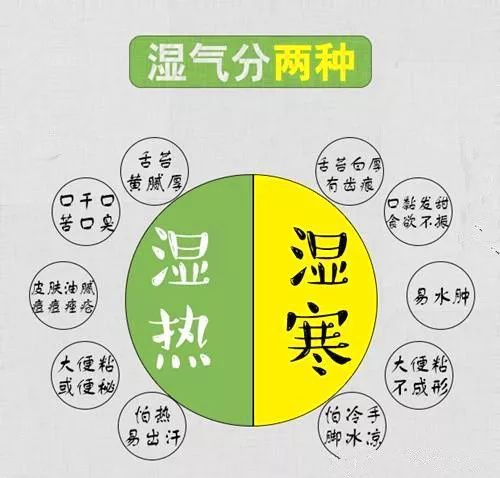
9.Additionally, an increase in abdominal fat can also serve as a standard for determining cold dampness.
Now, regarding the judgment of the main force of dampness, “cold damp”, I need to go check my tongue in the mirror; I suspect it’s not in good shape either. It’s late, and if I keep writing, I fear that the yang cold damp will soon come to befriend me.
Speaking of cold damp without mentioning damp heat, are you going to collapse my bed?!
Alright, let’s satisfy everyone! Now let’s talk about damp heat.

This person trying to mix into the cold damp group has been caught by me; look at this red tongue and thick, greasy yellow coating, typical of damp heat. She should check her stomach with an endoscope; she definitely has gastritis and didn’t come to me for reimbursement.
What are the manifestations of damp heat?
1. The face always looks unclean. Complexion is yellow, dark, and oily.
2. Teeth are yellow, gums are red, and lips are also red.
3. Prone to acne, especially pustular acne, which is red, swollen, and painful.
4. Dry mouth, bitter taste, and bad breath. Strong body odor and sweat odor.
5. Constipation or sticky stools. Dark yellow urine with a strong odor.
6. Prone to tension, depression, anxiety, and anger.
7. If a person is thin, they are prone to abscesses (deep pustules).
8. Severe damp heat may lead to: abdominal fullness, nausea, loss of appetite, liver area distension and pain, alternating fever and chills, frequent urination, urgency, painful and scanty urination, abdominal pain and diarrhea, and purulent bloody stools with anal burning.
Any one of these points plus a damp heat tongue indicates damp heat!
Why might you have a damp heat constitution?
1. Long-term living in a damp heat environment, such as the Philippines or tropical rainforests.
2. Frequently consuming spicy, greasy, barbecued, fried, and cold foods.
3. Habits of smoking, drinking, and staying up late.
4. Long-term emotional repression, using alcohol to drown sorrows.
5. Hepatitis virus carriers.
6. Overindulgence in supplements.
3
Diseases Easily Developed by People with Damp Heat Constitution
People with damp heat constitution are prone to the following diseases (even if not currently affected, vigilance and prevention are necessary):
1. Skin issues: seborrheic dermatitis, rosacea, pustular acne, folliculitis, carbuncles, and abscesses. Or lower body skin fungal infections, such as tinea corporis, tinea cruris, and tinea pedis.
2. Liver and gallbladder diseases: hepatitis virus carriers, acute jaundice hepatitis, gallstones.
3. Infectious diseases of the urinary and reproductive systems. More prone to bladder infections, urethritis, and pyelonephritis during periods of excessive fatigue. WeChat public account: Spinal Health Alliance
4. Muscle and joint fatigue. Prone to back pain and body aches.
5. Diabetes, hypertension, and stroke: high blood sugar and high blood lipids can all be attributed to excessive dampness.
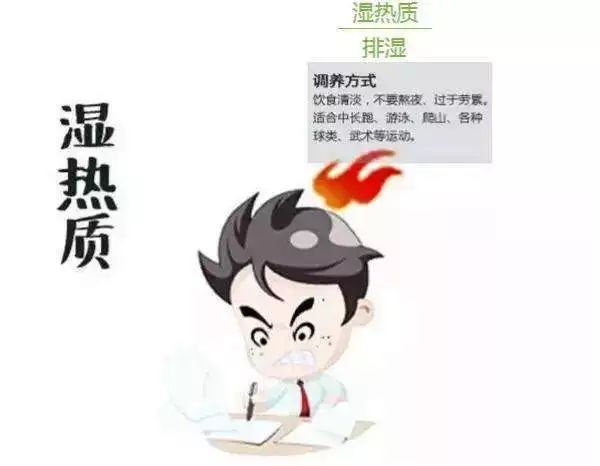
4
The Four Major Taboo Practices for Dispelling Dampness
1. Cold foods and drinks
As summer arrives, many women enjoy cold drinks and ice cream. This habit is very detrimental. Overconsumption can lead to stagnation in the digestive and absorption functions of the stomach and intestines, creating a breeding ground for dampness in the body. I personally recommend adding some scallions, ginger, and garlic to meals to reduce the cold properties of foods.
2. Frequently using air conditioning
In the hot summer, it’s hard to live without air conditioning. However, air conditioning is the most likely to cause dampness. Spending all day in an air-conditioned room can subtly introduce dampness into your body. I personally suggest minimizing air conditioning use and exercising more when possible.
3. Staying up late
From a TCM perspective, staying up late can lead to spleen deficiency. Adequate sleep can make us more energetic. I recommend going to bed before 11 PM; waking up the next day will not only make work and life more efficient but also make you feel lighter overall.
4. Alcohol consumption
Moderate drinking can be beneficial, but excessive drinking can increase dampness in the body. From an expert’s perspective, alcohol can promote dampness, especially for women, who should avoid alcohol as much as possible.

5
Two Approaches to Dispelling Dampness
Let’s first look at the first method, which is what TCM refers to as light diuresis. Taking Fu Ling (Poria), Ze Xie (Alisma), Yi Yi Ren (Job’s Tears), Chi Xiao Dou (Adzuki Bean), and Lian Zi (Lotus Seed) all belong to this method. These herbs or foods have good effects, but this method has a fatal flaw: it can eliminate already formed dampness but cannot prevent the reformation of dampness, thus not addressing the root problem.
This leads us to the second method, regulating Qi flow. As mentioned earlier, the essential characteristic of dampness is stagnation; what can counteract stagnation? Of course, it is movement. Among the five organs, the liver (wood) is associated with movement, while the spleen (earth) is associated with stagnation. Therefore, the principle of wood overcoming earth applies here. A slow person who is always lazy needs a more active person to motivate them. Thus, the specific implementation of the second method is to strengthen the spleen and soothe the liver. Strengthening the spleen is to enhance the lazy person’s strength, giving them the energy to exercise; soothing the liver is to speed up the body’s rhythm, allowing Qi to flow smoothly, thus dispelling dampness. For strengthening the spleen, one can use Si Jun Zi Tang (Four Gentlemen Decoction), and for soothing the liver, one can use Xiang Fu (Cyperus), Su Geng (Perilla), Yu Jin (Curcuma), and Bai Shao (White Peony). WeChat public account: Spinal Health Alliance
Modern people tend to be lazy, often sitting still, so many have a damp constitution. The dampness in modern times differs from that in ancient times; ancient people worked hard, and dampness was often externally induced, classified as external dampness, which was effectively treated with the first method. Modern dampness stems from laziness, so the second method is more suitable. Of course, relying solely on herbs is not the best approach; the best method is to overcome “laziness” and engage in more physical activity.
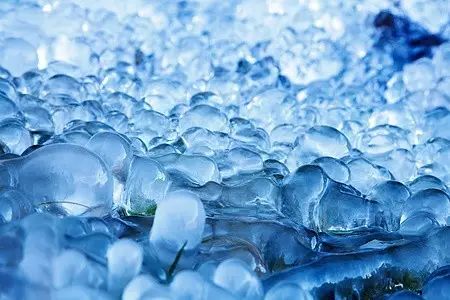
6
Formation and Prevention of External Dampness
Formation
External dampness often occurs in summer, especially during the long summer (the sixth lunar month), when dampness is predominant due to the rainy climate and humid living conditions. The damp air can affect the circulation of Qi and blood and the functional transformation of the organs.
Prevention
Keep your living environment dry;
Regularly air out bedding and other linens;
Keep indoor spaces well-ventilated, as wind can dispel dampness;
Ensure smooth sweating, avoiding excessively low indoor air conditioning temperatures;
Placing charcoal indoors can help absorb moisture;
Treatment
★Food
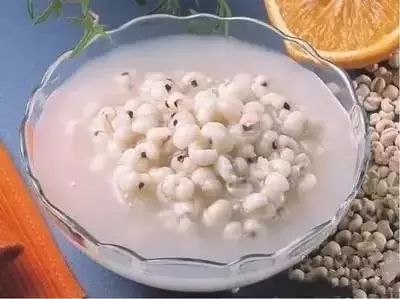
Adzuki Bean and Job’s Tears Porridge
30g of white adzuki beans, 30g of roasted job’s tears, and 100g of rice, cook into porridge, and consume one bowl for breakfast and dinner.
Preparation:Soak the white adzuki beans and roasted job’s tears in cold water for 2 hours, then cook with rice until the job’s tears are soft.
Note:Job’s tears must be cooked until soft; otherwise, it may cause stomach pain and bloating. If used for damp heat, raw job’s tears can be used, which is more suitable for various skin diseases of the damp heat type.
★Drink
Lotus Leaf and Tangerine Peel Tea
3g each of lotus leaf, dried tangerine peel, and roasted barley.
Method:Soak the herbs in cold water for 30 minutes, then boil in water for 5 minutes, strain, and drink as tea once a day.
Note:Damp-dispelling herbs are used for thick, greasy tongue coating, soft and slippery pulse, disliking drinking water, fullness in the stomach, loss of appetite, and overall sluggishness due to water dampness obstructing the spleen. If there is yin deficiency with dry mouth and red tongue with little or no coating, or dry tongue coating, or a wiry, rapid pulse indicating excess heat, these herbs should be avoided.
★Medicine
If experiencing vomiting, diarrhea, loss of appetite, disinterest in drinking water, and body aches with a white, greasy tongue coating, Huo Xiang Zheng Qi Water can be used for treatment. For damp heat with urinary difficulties, diarrhea, and a sticky mouth, Liang Yi San can be brewed and consumed as tea.
★Moxibustion

For those with dampness and prone to vomiting and diarrhea in summer, it is recommended to regularly moxibust the points Zu San Li (ST36) and Zhong Wan (CV12) during non-illness periods, using ginger moxibustion.
Moxibustion Method:Slice fresh ginger into about 3mm thick pieces, puncture several holes in the center, place on the acupoint, and then place a moxa cone on top. Use a lighter to ignite the moxa cone, and when it burns out and the patient feels a burning sensation, replace it with another moxa cone. Generally, moxibustion should be done 3-5 times until the local skin shows a slight redness.
Note:
During moxibustion, safety should be ensured to prevent moxa wool from falling off and burning the skin or clothing.
For excess heat, heat syndromes, and yin deficiency with heat, moxibustion is generally not recommended.
Areas of the face and major blood vessels should not be treated with moxibustion.
Pregnant women should not have moxibustion on the abdomen and lower back.

7
Formation and Prevention of Internal Dampness
Formation
Overeating rich and fatty foods, indulging in smoking and drinking; excessive consumption of cold foods can injure the spleen and stomach, leading to spleen dysfunction, which fails to transport fluids properly.
Being sedentary and overweight; emotional repression can obstruct Qi flow, leading to fluid accumulation and dampness.
Excessive indulgence in sexual activity; kidney yang deficiency can lead to spleen yang deficiency, causing fluids to accumulate internally.
Prevention
Reduce intake of sweets, meats, and animal fats to promote smooth Qi and blood flow, facilitating the distribution of fluids;
Avoid smoking and limit alcohol to protect the lungs and spleen, ensuring normal fluid distribution and transformation;
Engage in regular exercise. Movement promotes yang, while dampness and phlegm are yin evils; only smooth circulation of Qi and blood can prevent the retention of yin evils in the body;
Maintain an optimistic and open-minded attitude to ensure smooth liver Qi, allowing normal Qi flow and preventing the spleen from being obstructed by the liver, thus ensuring normal fluid transformation;
Moderate sexual activity to maintain sufficient kidney Qi, which can warm the spleen and stomach, ensuring normal fluid transformation.
Treatment
★Food
Fo Shou and Lean Meat Porridge
Ingredients:15g of Fo Shou, 30g of lean pork, 50-100g of rice, scallions, a slice of ginger, salt, vegetable oil, and sesame oil. WeChat public account: Spinal Health Alliance
Preparation:First, wash the Fo Shou purchased from the pharmacy and soak it in cold water until soft. Chop the scallions and ginger. Mince the lean pork. Heat a small amount of vegetable oil in a wok until hot, add the minced pork and stir-fry until it turns white. In a porridge pot, add rice and water, bring to a boil, then add the pork and Fo Shou, and continue to simmer until the rice is soft. Add scallions, ginger, and salt, and cook for another 10 minutes, finishing with a few drops of sesame oil before serving.
Tips:
1. Ginger can warm the middle and harmonize the stomach, but it is spicy, so adjust the amount according to personal taste;
2. Fo Shou is a commonly used herb for treating stomach diseases and is also a common food. It is warm and spicy but does not have the drying and damaging effects of heat. It can soothe the liver and regulate Qi, transforming phlegm and relieving chest tightness. Using Fo Shou is not for dispelling dampness but for soothing the liver to prevent the spleen and stomach from being obstructed. It is often used for stomach distension and pain caused by liver Qi invading the stomach.
3. The amount of vegetable oil should not be excessive, as too much can also generate phlegm and dampness.
★Drink
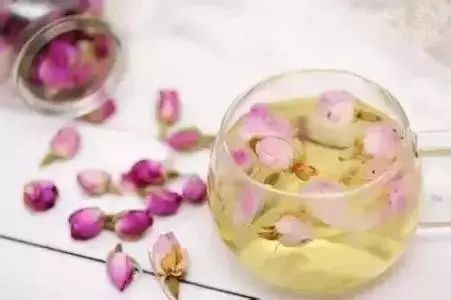
Rose Tea
Method:Take 6 rose flowers, brew with boiling water until fragrant, and drink as tea.
Tips:1. Rose has a sweet and slightly bitter taste, is warm in nature, can promote Qi and relieve depression, and harmonize blood to stop pain. It is effective for Qi stagnation and blood flow issues, stomach pain, dysmenorrhea, and irregular menstruation; 2. Due to its blood-activating properties, it should be avoided by pregnant women and those with bleeding disorders; 3. Rose itself does not have damp-dispelling properties; it is used here to soothe liver Qi and regulate Qi and blood; 4. Due to its warm nature, it should be used cautiously by those with yin deficiency, red tongue with little or no coating, and dry mouth.
Medicine
For stomach dysfunction caused by liver Qi invading the stomach, leading to symptoms like stomach distension, pain radiating to the sides, chest tightness, and difficulty in bowel movements, Shu Gan He Wei Wan can be used for treatment. For acid reflux and stomach pain with a burning sensation, Jia Wei Zuo Jin Wan can be used for treatment.
Acupoints
For those with liver Qi stagnation, poor Qi flow, irritability, work stress, and depression leading to spleen and stomach dysfunction, acupoints Tai Chong (LR3), Nei Guan (PC6), and Zu San Li (ST36) can be stimulated with a blunt toothpick. Each acupoint should be pressed for 3 minutes, once a day.
Tips:When using a toothpick, be sure to use the blunt end. If the stimulation is too painful, fingers can be used instead to press the acupoints until a feeling of soreness and distension is felt. If using fingers, it can be done 2-3 times a day, pressing each acupoint for about 5 minutes.
In summary, to combat dampness, which is a “yin” evil, we should use “yang” methods to adjust. Avoiding rich and heavy foods lightens the burden on the organs, maintaining an optimistic attitude ensures smooth Qi and blood flow, and regular exercise promotes smooth circulation of Qi and blood, thus leaving no place for dampness to hide.

